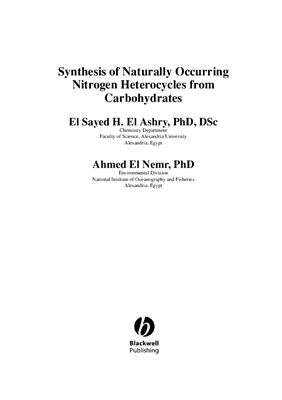Blackwell Publishing Ltd, 2005. - 443 p.
Carbohydrates, such as starch, are extensively used as feedstocks by the chemical industry; similarly, derivatized carbohydrates are increasingly used by organic chemists as starting materials in the synthesis of chiral heterocyclic compounds. The aim of this book is to review the recent literature dealing with the use of carbohydrates as raw materials in the synthesis of naturally occurring nitrogen heterocycles. Although carbohydrates have been used for the synthesis of other types of heterocycles, we have limited our review to their use in the synthesis of naturally occurring nitrogen heterocycles. This limitation was dictated by the extremely large number of publications that has appeared on the subject during the last two decades and our desire to give the reader as much information as possible in the confines of our book. We have not merely cited references for a given synthesis but instead have given as much detail as was possible on the experimental conditions used. The text contains six main chapters arranged according to the size and complexity of their heterocyclic rings, ranging from five- to seven-membered rings and from single to multiple fused rings. The book gives enough information on the synthesis of the compounds to enable a chemist to design a multistep synthesis. It cites the different approaches to the synthesis of naturally occurring nitrogen heterocycles in a format that enables the reader to make comparisons with other methods and make decisions on whether to use a certain procedure, modify it or devise a new synthetic methodology. In summary, the book is not a mere list of the conversion methods cited in the literature, but rather a rational discussion of these methods. Of course, the large volume of literature cited has dictated that some references be discussed in less detail than some readers would have liked, but we hope that they will understand our difficulty and forgive us. We feel that the added information in our reference book will be of greatest value to chemist in both industry and academia, and to researchers and graduate students in the fields of organic chemistry, medicinal chemistry, heterocyclic chemistry, natural product chemistry and glycochemistry.
Five-membered nitrogen heterocycles
Five-membered heterocycles with two heteroatoms
Six-membered nitrogen heterocycles
Seven-membered nitrogen heterocycles
Fused nitrogen heterocycles
Multi-fused heterocycles
Carbohydrates, such as starch, are extensively used as feedstocks by the chemical industry; similarly, derivatized carbohydrates are increasingly used by organic chemists as starting materials in the synthesis of chiral heterocyclic compounds. The aim of this book is to review the recent literature dealing with the use of carbohydrates as raw materials in the synthesis of naturally occurring nitrogen heterocycles. Although carbohydrates have been used for the synthesis of other types of heterocycles, we have limited our review to their use in the synthesis of naturally occurring nitrogen heterocycles. This limitation was dictated by the extremely large number of publications that has appeared on the subject during the last two decades and our desire to give the reader as much information as possible in the confines of our book. We have not merely cited references for a given synthesis but instead have given as much detail as was possible on the experimental conditions used. The text contains six main chapters arranged according to the size and complexity of their heterocyclic rings, ranging from five- to seven-membered rings and from single to multiple fused rings. The book gives enough information on the synthesis of the compounds to enable a chemist to design a multistep synthesis. It cites the different approaches to the synthesis of naturally occurring nitrogen heterocycles in a format that enables the reader to make comparisons with other methods and make decisions on whether to use a certain procedure, modify it or devise a new synthetic methodology. In summary, the book is not a mere list of the conversion methods cited in the literature, but rather a rational discussion of these methods. Of course, the large volume of literature cited has dictated that some references be discussed in less detail than some readers would have liked, but we hope that they will understand our difficulty and forgive us. We feel that the added information in our reference book will be of greatest value to chemist in both industry and academia, and to researchers and graduate students in the fields of organic chemistry, medicinal chemistry, heterocyclic chemistry, natural product chemistry and glycochemistry.
Five-membered nitrogen heterocycles
Five-membered heterocycles with two heteroatoms
Six-membered nitrogen heterocycles
Seven-membered nitrogen heterocycles
Fused nitrogen heterocycles
Multi-fused heterocycles

